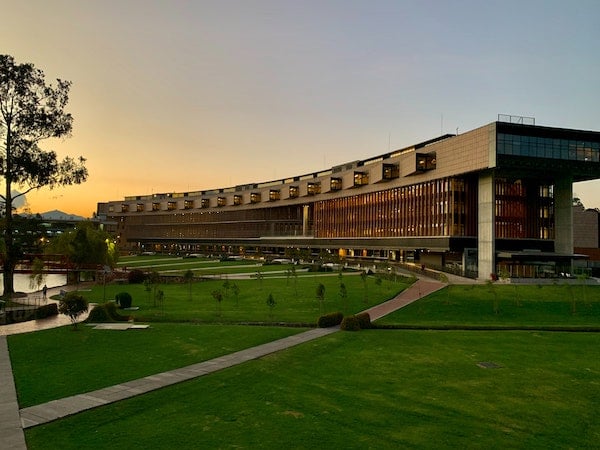Published on
The Changing Role of the Modern Community College

Community colleges often have their ability to give students a valuable educational experience overlooked. The pandemic shifted this perception and illustrated how vital community colleges are in serving communities and meeting industry needs. Going forward, higher ed needs to support them to strengthen and serve their mission. In this interview, Michael Baston discusses the vital role community colleges have played during the pandemic, how to execute the institution’s mission and the fundamental changes needed to meet the needs of learners and the community.
The EvoLLLution (Evo): How has the pandemic changed the role of the modern community college?
Michael Baston (MB): The reality is that the crisis became our classroom. In the midst of the crisis, we had to really clarify those things about the community college that were top of mind and most important. The country began to recognize that many of the critical services, supports and people who help us and helped us navigate that crisis came through because of attending a community college.
That was the awakening to what our real needs are and the fragility of our country’s infrastructure. We finally, as a brave enough and strong enough country, understood our vulnerabilities. We understood the fragility of a health-related emergency with economic impacts. We felt this during a period of time when we were also recognizing the racial unrest and the social justice challenges that we face. What are democracy’s front-door gateway institutions? Which institutions are providing the educational opportunities and ladders to opportunity at a price that people can afford in their community? Community colleges.
The community college’s critical nature and contribution really surfaced and has become clearer. The country’s distribution chain is clearer. The critical link tying the community college to the United States’ rebound, is clearer than ever. And unfortunately, it took a pandemic for the world to recognize the critical work community colleges have conducted in their communities.
Evo: How have the last 18 months changed the light that shines on community colleges’ workforce development mission?
MB: Critical dependency on folks to actually help you live has now come out of this. Delivery workers gave people a sense of normalcy during the pandemic. We have the evidence for the idea that there is a whole community that needs access to opportunity because we depend on them. If we were able to come through at the current level of investment, what will be the next level of investment? This investment would prepare us for any scenarios like this in the future.
The reality is that it’s in our best interest as a country to begin strengthening our infrastructure to ensure that people have the opportunities to rise. You can’t keep people in low-wage situations and presume that they will not stay in a permanent underclass. If we really want to address diversity, equity and inclusion, then you’ve got to take steps beyond statements. You cannot simply say that we want to be more equitable. We don’t recognize the impact earning a low wage has on these workers. If we’re going to actually break the back of the caste system of opportunity in this country, we need to address it from the perspective of investment. We’re going to need to look at infrastructure not just as buildings but building people.
Evo: What are the obstacles that stand in the way of community colleges when it comes to actually executing that vision?
MB: Resources are always the biggest obstacle. If the current investments are for those who go for full-time educational experiences, and you can’t make more than a nickel, you’ll be penalized from participating in financial aid and other opportunities if you rise even slightly. There is also a disconnect between the federally determined cost of attending and the actual cost of living in your community under your unique circumstances.
You are investing in the current structures through financial aid policies. You’re investing in the fact that we don’t get financial support for short-term credentials. Ultimately, if we’re funded, more poor people could take these short-term credentials and move into higher-paying opportunities. If we give them credit for prior learning for their experiences, they can move up a ladder that would lead them to better opportunities. We have presumed that everyone attends college is full time, but not everybody can go to college full time. There are so many people in this country—over 20 million—with some college, no degree but who would love to return to school. Often people say community colleges are failure factories. They have such low completion rates. But are the other institutions failures if their students have some credit and no degree? People never look at any other institutional sector and count all of its students. They had no structure, no preparation and no exploration.
We have to recognize that often the community college does the job nobody else wants to do. Many four-year institutions aren’t going to do welding and surge tech. We believe that students should not be frowned upon because they find dignity and value in work and academic programs that are gateways to living the lives they deserve. That there’s value in the spaces where many four-year institutions don’t see themselves. Many middle-skill jobs lead to higher pay, so that people don’t stay in an underclass situation. We are the flexible, agile folks who offer the programs that will make a difference, but we are not currently funded to offer programs in ways that will truly democratize opportunity.
Evo: Where do maybe stackable microcredentials start to play a role in our new imagination of what post-secondary learning might look like?
MB: There’s certainly the space that community colleges are in right now in terms of resetting our engagement strategy. You’re seeing dual credit, dual enrollment more as one engagement strategy to work specifically with K to 12.
We’ll continue to work with them to do P-TECH schools and other career affiliated exploratory programs in high schools. There will be more stackable credentials in community colleges’ academic programs. This way, students don’t just get a degree but also earn various certifications along that educational pathway.
We’ll continue to partner with the workforce much more robustly. Now we have employers setting up their own credentials. But what we do offer is the power of our credentialing and confidence. We’re confident in the people in our community because we are the colleges in the community. It’s important for us to begin expanding our relationships with business and industry to continue meeting their needs.
The partnership with four-year institutions will be very important. We want to provide them not only with our wonderful wisdom and talented students—we’re also building a strategy to address structural racism in the country to equitable transfer. We have the opportunity to better prepare students who have been historically minoritized and marginalized, to put them in a position to thrive in four-year institutions in partnership with us through equitable transfer, to ensure we truly do diversify those four-year institutions with qualified, capable people who ultimately can rise. The baccalaureate degree and other credentials will put them at the highest level of opportunity to earn in a specific area of the workforce.
All of those relationships are where we become the critical connector. When we talk about how we are transforming and morphing between the pandemic, we’ve always been reaching out. But others are now recognizing the power of reaching back, and our ability to be a critical connector will be even stronger.
Evo: What impact does the college have, and what impact could it have, if these fundamental changes are made to support the capacity for colleges to execute their mission?
MB: Think about what we’re doing today. All around this country, community colleges are serving as vaccination centers as part of the president’s plan to vaccinate America. We are locally based and a trusted source in the community, so we’ve been on the front lines. It is our work that is making a difference in the country today.
We need to continue to think about the broader context. To what extent can we envision a country where every person who wants to be educated has the opportunity, access and support for success? At the end of the day, it’s the other costs of attendance, transportation, living expenses, food, childcare and care for parents. If we’re not going to strategically invest and address those challenges that far outpace the issue of tuition, then it hamstrings the opportunity. It makes us feel good to say, “free community college.” But if we’re going to say free, it has to be free of the burdens and barriers that keep students from making the decision between books and Pampers.
Evo: Is there anything you’d like to add about what it’s going to take for us to get from where we are today to where we need to go as a society, as an industry, to create the environment that community colleges need to operate in?
MB: Three things are going to be paramount. We have to see investment, and it can’t be one-time shot-in-the-arm investment. One-time investments, while helpful, do not in themselves create a long-term financial return. It provides a short-term ability to make it through a difficult time, but it can also provide a sense of false hope.
The country has to make some investments. It has to treat all students as students. So, we have to break down this concept of, “If you’re not a full-time student, then there’s something wrong with you.” Many of our students, particularly in the community college, can’t attend full time. If all part-time students went full time, you wouldn’t have as many delivery drivers, for example. If they stopped doing that to only focus on school, we would be in a very tough spot.
We’ve got to think about how we engage in investment in this country. We need an investment strategy for community colleges that places a premium on understanding how people actually navigate the system.
We need federal funding that allows us to reward short-term credentials as a ladder to larger, more long-term commitments that will benefit the country. There has to be an incentive to see the K to 12 system in a community college, the community college in a four-year space, and business and industry and the community college integrated. It has to be a national strategy for innovation, success and competitive opportunity.
There’s now an interest in rural areas for investment. Some of the greatest devastations happen in the suburbs. There’s a feeling that the American dream is slipping away. So, I would challenge all folks to think about this work. How will we use the community college as a strategy to revitalize the suburbs, rural and urban areas? There’s a need everywhere, but there’s a presumption that the suburban ’50s still exist.
This interview was edited for length and clarity.
Disclaimer: Embedded links in articles don’t represent author endorsement, but aim to provide readers with additional context and service.
Author Perspective: Administrator
Author Perspective: Community College



